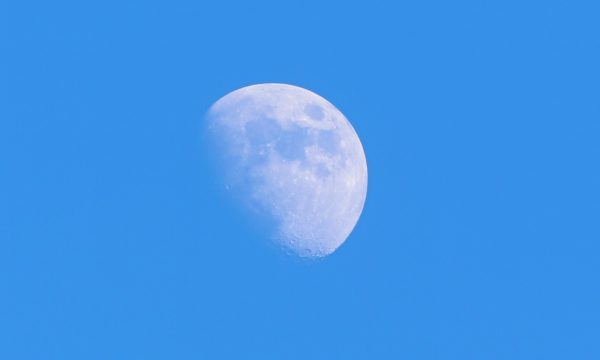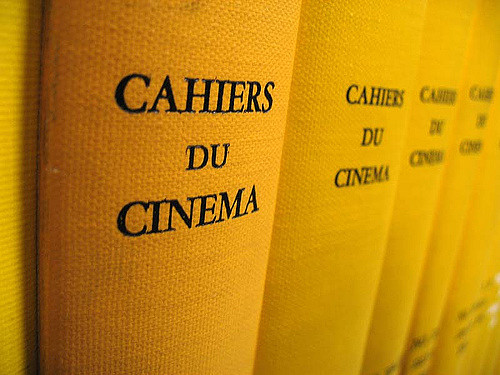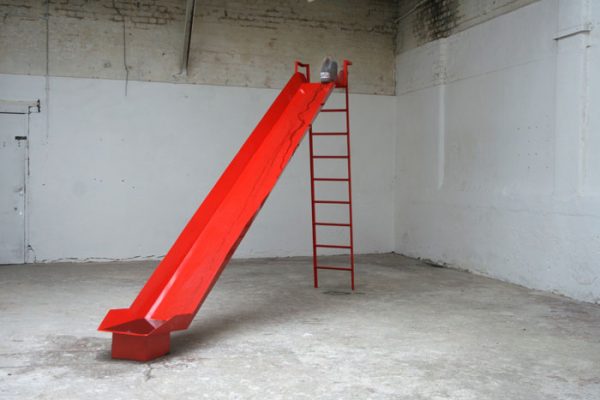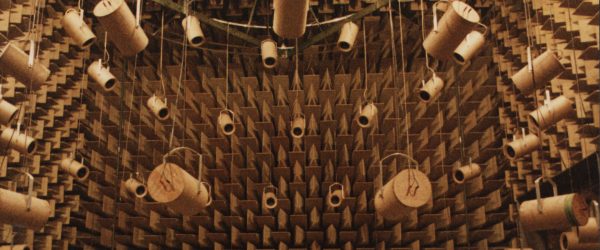My first impression was of a tall building laid down for a nap, with all its parts nestled together side-by-side. The lawn in front seemed out of place, discoloured by spots. I moved into the spare bedroom of my grandfather’s house and started my new teaching job at a local college. They’d hired me to teach video game environment design, but I was still too young to own real furniture. On free days I drove my grandfather to his haematology appointments. He navigated our route and swore at the German nurse who drew his blood in German. She laughed from her belly and called him a hick, because he spoke in a dialect, just like his parents, who came from a German-speaking village in the Ukraine. In the mornings I made elaborate coffees while he rested at the kitchen table, cracking his knuckles. He often spoke to his friends on the phone in a low, rhythmic voice I couldn’t follow. I remember wiping down the red Formica counters and thinking that perhaps the lawn was diminished due to stress. Then a pox of barren patches swept up from the street, and what green remained just withered and crisped.
I looked online and certain companies can be hired to paint your grass the appropriate colour, which is the solution I would have entertained, had it been my lawn. One day I walked around the side of the house and found the irrigation switch turned off and taped over with a big black X. I recognised this intervention as my grandfather’s handiwork, perhaps a statement about the drought, a water conserving measure, or who knows what. I wasn’t too surprised.
So I went to work and flirted with the product designers. They wore dark-rimmed glasses and were the best dressed of anyone on staff. I mentioned the immaculately restored 1950s single-story home where I’d deposited my trash bags full of shoes. One of them bought me three martinis, and though he hadn’t yet seen my grandfather’s house, he described its features: A simple floor plan sprawling out instead of up, an attached garage and sliding glass doors that opened onto a patio. A rambler, he called it.
We leaned on the dark red bar. He swirled his drink with a massive hand. The way he sat reminded me of a desk lamp. On some speculative tract of land in the early twentieth century, he told me, modernist architecture had sex with an older, rugged adobe ranch house, and spawned the California ranch style home. We grew up on twin beds in these houses, he said, but never gave them a second thought. The California ranch house is almost too practical, flexible and informal to notice. After WWII, they were mass-produced in the now familiar whorls of suburban homes, he said, which viewed from high above resemble pixelated egg sacs, as if laid by a cosmic amphibian, dense in the West but seeded all the way to the Atlantic.
Everything you’ve said is true, I told him, but this particular house is like a shrug. When I pad around the carpets at night, I sense the drywall panels, stucco and stone appliqué as they slowly squeeze upward into the long, pinched nerve of the roofline. The product designer had cantilevered his rangy torso out over the bar. He became quite animated and offered more martini-driven theories. With time, he told me, each of these older ranch style houses has matured into a unique anxiety, phobia or compulsion. As with any aging body, he said, there’s an intimate connection between architecture and pathology. When he unpeeled himself from the bar stool, I shook out my hair and swiped his beer mat for my collection.
Early the next morning, I ventured out to fetch my grandfather’s newspapers. Mrs. Calvin caught sight of me and tottered across the street in peep-toe wedges to say hello. I felt as unsteady as she looked, my head in pain proportional to my recent vodka dilutions. I grabbed the newspapers, noting the rotation of the earth. A tuft of dead grass curled around my ankle. For a moment I stood motionless, and with one hand propped against our mailbox, I complimented Mrs. Calvin on her fine emerald lawn. Her thanks came back light as a badminton cock, while her cheeks flushed with a burning, neighbourly curiosity.
In October the days began to darken and contract, like fingers pulling inward to make a fist. The weather cooled by a few degrees; it rained twice. The rows of succulents bordering the house extruded their tendrils of aqua, rust and amber at a creeping pace.
I made us soups for lunch. One afternoon we had a beef stew with sauerkraut and dill, which my grandfather said he liked but didn’t finish, and afterwards I draped myself across a folding chair next to the garage, watching him from a distance. He stood on the stone slab outside the front door, leaning on his cane. The blade of his scapula poked through his shirt. By now he stooped so low that every time I saw him I felt a sympathetic pain. I felt it no matter how many times he assured me he was comfortable. Every day I rotated his opiate patch to a new square on his back, or to his chest, which had always been more tan, where his skin now resembled sloughing bark, camouflage or reptile spots. When I was little I came across a picture of dragon lizards in the Galapagos and imagined that he kept one as a pet. He had the independent fire that all species of the Galapagos must possess, to have tumbled through evolution for millennia on rocky island outcroppings. Despite his catalogue of bodily troubles, his mind appeared as vivid and unknowable as ever. From my perch on the lawn chair, I remembered a line he often told me, from one of his books on information theory, written by a man named Gleick. I never knew whether he meant it as observation or advice: Living things manage to remain unstable.
A large white delivery van backed up the driveway and parked. A man in cargo shorts stepped out. Other men dressed in canvas jumpsuits walked up the drive from trucks parked on the street. They wore beards like palm trees in silhouette: Dark bristles, brushy at the top and tapered. One of them had a small paunch. I watched him walk the length of the unmarked van, his gait dipping with a limp, his eyes softened by long lashes. The rolling back door of the van sailed up, and he hopped up into the cavernous interior, which was empty except for a large wooden crate.
My grandfather stood to the side, leaning perilously, his pursed lips turned up at the corners in the most satisfied way. The supervisor held up papers for him to sign, making a subtle move now and then to steady my grandfather by the elbow. He had erect posture, a shaved head and pale folds of skin that oozed over his shirt collar like marshmallow, which I found strangely attractive. I suppose I felt off-duty, or at least momentarily relieved from my obligations as a caregiver. The supervisor directed handlers to remove the large wooden crate. They fetched hand tools from paint-spattered bins, while the bearded men stood around in an outer orbit. It was like a caste system based on hairlessness.
As the yard erupted, the two of us went back inside to wait for the delivery. Grandfather had purged major furnishings from roughly half the living room. He’d asked me to rearrange the low-slung leather sofa, matching recliner and glass coffee table into a more compact zone by the fireplace. After I pulled the drapes, we hovered in the doorway, not saying much, watching the afternoon light stream through the sliding glass doors. The bearded men approached, their shadows quivering on the concrete patio. They wore white cotton gloves and carried a massive sculpture wrapped in paper. It was an exceptionally tall figure, nearly eight feet long, and they manoeuvred it feet first into the living room through one of the sliding doors, at which point ten people and a giant sculpture were in our living room. I forgot to care about the carpet. I felt as much as heard the muffled sweating and breathing. The bearded men hoisted the sculpture upright and attached its feet to the floor. The toes sank into the carpet. One of the men climbed a ladder and began removing its costume of packing paper. He carefully unstitched each fragment of tape, and sheets of crinkled wrapping fell away.
Unveiled, a young boy stood near the centre of the living room. He held a frog in his outstretched hand. Both the boy and amphibian were proportional, but double their everyday size. The top of the sculpture’s head grazed the popcorn texture of the ceiling. His face was at the level of a fan or chandelier. Every surface of the sculpture was perfectly smooth, powder-white and gleaming, as if lit from within by a phosphorescence. My ability to focus had been neutralised. The boy’s features were reduced and abstracted, sapped of detail like boiled cauliflower. I saw a process of erasure, as if a real boy and frog pulsing with respiration had been super-sized, lightly effaced, and stripped of minor attributes so that only a choreography remained.
I lingered on the pose. Seeing the sculpture for the first time, it felt as if the boy was performing an action in the room. With his right hand, he reached out toward the sofa and dangled the frog by one leg.
The evenings were my favourite time. I turned on the teardrop lamp in the living room, and we left the rest of the house to the dark. A dirty, malted light sifted through the drapes from the street. Sometimes I had the urge to dust after it had touched the shelves. The ambient gloom felt unstable, radioactive. It reached around doors, becoming ever more dense, corrupting colour and staining the walls.
Grandfather sipped his scotch in the recliner. He wore shorts with socks pulled up to his mid-calves and tennis shoes. His legs were dotted with bandages from poorly healing wounds. Every time I turned around he’d started bleeding again, if he ever stopped. I lay back on the couch, embedded in pillows, reading about frogs. After a while I said:
I’ve been driving around the neighbourhood taking pictures of ranch houses like this one from the street. Thinking back I can’t visualise the exterior of a single one. They’re like bread crusts. Who could recall, even a really great baker, the shape of an individual loaf? And does it matter? Yet when I’m here, I sense the empty space of this house, as if its hollows and vacancies were an invisible, extra-dimensional organism. I should model this emptiness for a game environment. Perhaps it is one already. As you know, this semester I’m teaching the fundamentals of video game environment design. My students are terrible. One guy draws dicks on chairs. Another did a backflip as I lectured. Every clique has a stinky person. Some of them carry concealed weapons. They expect A’s for showing up, yet I’m able to motivate them with prizes they could easily buy. I bring them vats of red vines and fireballs, and I tell them that the best video games captivate us with an illusion of freedom. In these worlds, we are not free to act. We pursue those few behaviours that engage us most powerfully with the system.
But I digress. The important topic tonight is frogs. Did you know they have respiratory options? While underwater they breathe through their skin. Though what we call skin is for them a jelly thin, permeable, membranous tissue. When they’re poised, maybe on a log, with their stout bodies, protruding eyes and limbs folded underneath, they’re taking sips of air. Outside of water, they breathe through the tissue of their palate, that delicate mouth arch where retainers go. If a frog had a retainer, it could suffocate. And to top it off, they’ve got miniature nostrils and lungs. Of course the frog is a delicacy in some cuisines, and I forget they’re carnivores. Their jawline, as substantial as a matchstick, sports a ridge of pointy, not-very-straight teeth. I remember standing by a creek when I was little, cupping my hands with a frog trapped inside, gelatinous and squirming against my palms. Then it peed on me.
I waited for grandfather’s response. At some point, he shifted in his recliner and said:
When I was a boy, your great-grandmother used to tell me that you can’t pull hair from a frog. She did the dishes every night, and at some point in her domestic routine she repeated phrases like this in her peculiar, pioneer dialect. Even after she knew the words had lost their meaning. I believe they gave her comfort. Please, my dear, go on.
Yes, I said, and I continued:
The sculpture has been here a week now. I’ve been watching it all this time and I can’t find a flaw. Every day it seems slightly different, as if we’ve taken in some resplendent fugitive. I’m reminded of the ancient fantasy, shared by many if not all cultures, of a statue imbued with the power to move, speak or breathe. I think this sculpture is doing a respiration. An exchange with its environment. A breath-taking. Not of gases, but of something far more abstract. There’s so much information in the boy’s shoulders. By his posture and shape, I’d guess he’s five years old, but scaled up to eight feet tall. A gargantuan, naked youth, white as milk, looking down on us. What world does he come from? The deliverymen said that he and the frog are made of painted fiberglass, which I would never have guessed. The surface has such a fine slickness. I can’t stop looking at the seamless arrangement of its parts. The boy’s abdomen is distinctively rude, protruding and full, yet taut, as only young children carry themselves. He stands with a slight twist, gripping the frog by one leg, and the amphibian is left to dangle in the most vulnerable way. Its little hands snatch the air. All the while the boy peers down at the frog with shadows in his eyes and an unplaceable gaze. I can’t decide if he feels interest, contempt, amusement or all three.
Grandfather, did you know that frogs enter a state of torpor and lie dormant for months? In colder climates they hibernate. Land-dwellers might dig a burrow, find a crevice or bury themselves in dead leaves. The aquatic ones sink to the bottom of ponds, where they rest, semi-interred in mud. Their metabolism slows. They absorb oxygen through their skin and consume only their slight reserves. Alaskan wood frogs have adapted to the most brutal of winters. When ambient temperatures dip below freezing, ice crystals form inside them and they freeze like popsicles. And they can stand it colder still, as the temperature plummets to minus three degrees Fahrenheit and maybe even less. We don’t yet know how cold these frogs can go. They are somehow able to muster a concentration of glucose and other mysterious, as-yet-unstudied compounds, to protect their tissues from shrinking and cracking like the ice. Across the tundra, hidden by a veil of snow, they solidify into the deepest and darkest of sleeps. Their hearts stop beating. They no longer breathe. Their frozen bodies are contorted, purple or bluish in color; their eyes an uncanny, pure white. Nothing circulates inside them, and in the absence of any flow – blood, bile, electrical impulses, or other substances – their cells become utterly isolated from one another. In this state, it is hard to imagine how they could be counted among the living.
After months spent as silent and immobile as our sculpture, these lifeless, frozen frogs thaw out in the warmth of the spring sun. By some undiscovered mechanism, a secret that nature holds close to her chest, their hearts restart. And they emerge, reanimated, into the day.
These words hung in the air as we dozed.
The next morning I put on a black leather jacket and my design pants, which looked like attire for construction, except they were blood-orange with reflective silver at the seams and cost a lot. I did my hair as high as possible on teaching days. After coffee at home, I stopped for a few more and reviewed my lecture notes, gradually making my way to the college, a glass-panelled building with parking in front. The lobby was full of single mothers, young veterans, salty-haired older men and teenagers with every kind of piercing. Hopeful applicants gathered at the wood-veneer orientation desk. They took numbers, carried papers under their arms and glanced down long vistas of carpeting. I said hello to the students of acupuncture in the hall.
Ten minutes after the hour I backed into the classroom with several tubs of candy in my arms. I fired up the old overhead projector and slapped a red vine down on a sheet of clear transparency. A four-foot whip of red liquorice lit up the projection wall behind me. The room was silent except for a ringtone, which sounded like a pug breathing. The tub of red vines sat next to me, open. I stared at the assembled students for the amount of time I imagined it would take to eat a piece of liquorice. Then I began to speak:
Imagine yourselves in the fifteenth century, wandering the halls of a turreted chateau above a river in the south of France. You ascend the spiral staircase, with balustrades carved from white stone pouring down around you like heavy, swirling cream. Alone in the arched passageways, a spacious room opens up before you. Magnificent carpets hang floor to ceiling in an immersive array. Woven from silk and wool, laced with gilt thread, they depict the hunt for a unicorn in seven frames. These are the famous unicorn tapestries. Hunters in medieval dress sweep through deep green woods, every inch spangled with flora. The unicorn is flushed, blood is shed on both sides, and in the final frame, our most elusive symbol of purity is stabbed and killed. The dead unicorn’s horn is cut off, its limp carcass slung over the back of a horse and presented to the lord and lady of the castle. No record remains of the weavers’ intent, or even of the wealthy individuals who must have commissioned their work. Now the tapestries hang in New York, in the collection of the Metropolitan Museum as a special tourist destination. I believe they persist as a reminder. We’ve been working for hundreds, if not thousands of years to weave the skins of worlds we might enter.
Behind their shape shifting, video games are engines built on code. They may take many forms and bewilder us with profusion, but they stand alone as phenomena distinct from other arts. Here we glimpse the essence of our sprawl. Whether we play Grand Theft Auto or walk the actual streets of Los Angeles, we’re responding to the rules of our environment, and at the same time, imagining a fictional world.
I threw staccato bursts of fireballs at the students. Small, red, spherical, hot cinnamon candies wrapped in plastic. Mostly at the ones who were paying attention, occasionally at some who weren’t. They responded with whatever swiftness and agility they’d developed in their gaming. It was an illustration of partial reinforcement, a vital concept for their next exam, though I hadn’t brought it up yet. They needed me to be concrete.
Between shots I said:
Stitch your thoughts to your environment. To your actions. Wherever you go, reach toward a form of thought embodied in your movements. To engage the game, you must be able to think it.
Later, as your ideas mature and you begin to produce your own little games, you’ll ask yourselves the average questions: Is my game objective compelling, does it sprout urges in its players? What spectrum of failures have I sketched, what catastrophes and deaths? What textures and landscapes of uncertainty, the most subtle of tools, might my players savor? Don’t stop there. This is only the beginning.
And I asked myself:
Do you think you know what a sculpture is?
What a sculpture does?
When I got back to the house, I took off my shoes and headed to the spare room. Grandfather was on his exercise bike, hunched and pedaling at an exceptionally slow rate. He’d purchased this spindly, ice blue slice of equipment in the late seventies. With his pure white hair and goatee, his full belly and thin arms, he looked like an ancient rat in a laboratory experiment. Albeit one with erudition, dignity and traces of Russian folk demonology. He bristled at any hint of pity, so I stood in the doorway and asked him challenging questions instead:
Is the sculpture considering itself? Has the sculpture hung itself by one leg, dazed and terrified? For some reason, I’m thinking about the overwhelming amount of frog species now extinct.
They’ve croaked, he said, completing another rotation of his pedals.
I did the laundry, sat on my bed and rearranged the bathroom towels on a rack made from ornamental plumbing. I folded clothes at the kitchen table and forgot about them, shuffled magazines and wrote speculative notes about the students for my research. Wherever I moved, I felt a vague restlessness. The boy and his frog seemed to follow me. When I couldn’t see them, I thought of them more.
Not knowing what to do, I went to visit my friend Reuben. He lived behind True Value in a little house next to the freeway. Up on the roadbed the cars floated by like silverfish. His ramshackle Craftsman looked sunburned, with peeling sky-coloured paint. Chain link fencing looped around the dirt yard and a fantastically large disco ball hung over the door. Reuben had a stocky build, dark hair and a beautiful, thin mustache hovering between his nose and upper lip. He drew illustrations for a Catholic anarchist newspaper and taught Gregorian chant. We hung out in his kitchen while he made us mushroom tonics from a substance that resembled the dust in his yard. In response to his questions, I said:
I think you’ll understand this, Reuben, because you’ve studied both architecture and poetry, and you keep a nineteenth century letterpress machine in your closet. A few weeks ago, my grandfather purchased a rather famous sculpture. He had it installed in the house. Now we have a young boy as high as the ceiling with a frog clasped in his palm – an elephant, so to speak, in the living room. Also, the lawn died. Otherwise not much has changed. When I’m not working, I do things around the house – domestic errands, cooking and odd jobs. Sometimes we watch television together. I wish my grandfather would heap logistical burdens upon me, or distracting forms of busyness, because I feel powerless to really help him. He isn’t well, and he’s past the point of getting better. We’ve stopped mentioning the future. When I’m in his house, odd emotions haunt me, and I find myself shedding tears at unusual times. My grandfather is a stranger with whom I share something impossibly intimate. I don’t know what passes between us. I feel like there are questions in the sculpture that will help me understand. Something about Pygmalion, I don’t know.
From what I remember, as Ovid tells it, Pygmalion sculpted a figure from ivory so true to life that it was magically transformed into flesh. I think the interesting part of this story lies in its beginning, in the choices Pygmalion made as he worked. Yesterday I put the pillows back on the couch and I wondered: Does the boy want to be alive? My eyes slip across him, he may be melting away. There’s a sense of disappearance in his lack of detail. His arms and legs are perfectly smooth, yet precisely articulated in space, with the muscles of his back lightly defined by shadow. It looks as if weakened, cold or mildly paralyzed hands have buffed away at his features, except for his genitals and the frog, which retain this softness but with more detail. There’s a sense of lightness suited to video games. They’re contemporaries. I suppose this sculpture doesn’t aim for the realm of the living. Out of the corner of my eye, I almost suspect the boy might move, but he could never be flesh. He’s as weightless and abstract as these thoughts, a pale mass both here and not here, with just enough specificity to exist.
When I left, we went to hug and Reuben kissed the region of my cheek, partially covered by my long hair, with the softest and sweetest of kisses. I walked to my car holding that flame in my chest, letting it spread, incubate my solids and finally dissipate in idle thoughts.
Grandfather was still up when I got home, hunched over in his moonlit kitchen, watching the goats in the backyard from the window over the sink. I fed them in the evenings, down at the edge of the lot. They’d made a nest of sticks, a delicate construction in the blackberry bushes where they slept. Goats have eerie, pale irises, and long, horizontal pupils like portals to a void, which give them increased depth perception and a mythic association with the devil. I mentioned to grandfather that certain species of frogs have square pupils.
Before we let the sculpture affect our thinking, he said.
The sculpture is affecting our thinking, I replied.
He laughed as we sat down in the living room. I laid back on the couch under a fake animal pelt, with a book about uncertainty in games pressed to my chest. It rose and fell with my breath. After a long pause, grandfather ruffled his eyebrows and said:
Today I thought of something that reminded me of your video games. Each time we pick up my prescriptions at the pharmacy, as we do several times a week, the clerk asks me to confirm my birthday. I was born on July 17, 1921. Many things have happened to me. Lately the memories come back, more of them than I knew I had, intensified or weakened in ways I don’t understand. They play in my mind like television, or maybe your games. If I put down a magazine or sit back in my chair, they seep forward and swarm, so that all I see is a spreading flow of pictures and images, the things we said and did, which I dip into and out of like a pool, and before I know it you’ve come home.
I keep thinking about the days after WWII ended, when I was a young pilot stationed on the naval base in Guantanamo, Cuba. One afternoon I flew out west, about five thousand feet up, and I saw a vast, pink blanket hovering in the air below me. It was made of flamingos. They were flying south in an undulating wave, two or three layers of birds high, about two miles long and wide. All flying together, like a tremulous, quavering pink cloud. I wondered what they saw, each upon each. I didn’t dare fly too low. Not only to avoid injuring them, but because a collision would be catastrophic. One bird could stop my engine. The stragglers flew at different altitudes, so I had to be cautious, but all I wanted to do was stare at that sight for hours. It was one of the most beautiful things I’ve ever seen. Maybe part of me is there again, alone in my plane above a wild, living sunset that covers the earth.
For an hour we sat in the dark with our whiskey and spoke freely.
Grandfather took to spending whole days and nights in his leather recliner. In the evenings he’d say: Move the boy a little closer. So I’d wedge myself between the living room wall and the recliner, pushing as hard as I could, perhaps moving his chair an inch or two toward the centre of the room.
First his toes died. They turned purple, then black at the tips. His circulation had declined to the point where his pulse barely registered at his ankles. In the absence of sufficient blood flow, our tissue dies. His doctors called this necrosis, a dry gangrene caused by thick and obstructed arteries. I learned these words and studied them. But secretly I couldn’t stop thinking of the word tissue, and whenever anyone said it I wanted to object, just to this word, which should be applied only to flimsy sheets tucked into gift bags by the lazy, and never to a man’s legs.
Then death crept over his arches to his heels, and up his ankles to the lower calves. A hospice nurse came once a day to change the dressings on his feet. They were turning purple-black, desiccating and cold to the touch. He grimaced and closed his eyes as she painted his feet with betadine, a dark-brown solution with a metallic smell, and wrapped his dying parts in gauze like a mummy. When she finished, she strapped him into tall sheepskin boots with velcro ties. They’d suit an astronaut, I said. He was in so much pain. I tried to joke and said that now his footgear matched the boy.
Even then, he still walked.
Boy With Frog is a sculpture by the Los Angeles-based artist Charles Ray.




